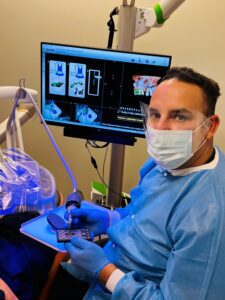Your Foundation Dollars at Work
Guiding the way: A JOE Basic Research-Technology 2023 publication award winner illustrates the broad impact of supporting the Foundation

Dr Frederico Martinho at the controls of a dynamic navigation system
Among the most recent papers recognized as best in class by the 2023 Journal of Endodontics Publication Awards, one stands out to illustrate the value and full impact of contributing to the Foundation.
“Real-time 3-dimensional Dynamic Navigation System (DNS) in Endodontic Microsurgery: A Cadaver Study” (J Endod 48(7):922-929) relates one in a series of projects conducted at the University of Maryland to help assess the efficiency, accuracy and even ease of use of a new technology in clinical practice. The study demonstrated that both novice and experienced surgeons using DNS completed minimally invasive osteotomies and root end resections in significantly less time with reduced virtual deviations, angular deflection and osteotomy dimensions than freehand. The published results were the first study covering all the steps of an apical surgery from start to finish.
“There’s a lot of options and considerations with new technologies which require a commitment and a bit of a learning curve and time investment before incorporating expensive equipment into a practice,” says Dr Patricia Tordik, endodontics division director at the University of Maryland School of Dentistry. “Whenever there’s something new that changes the way you’re used to doing something, it’s important to have research studies and good data to help make those decisions about how [they] would translate to practice.”
Clinicians can take away that “DNS gives them the tools to help treat some of the most difficult cases…having some technology that’s helping guide you so that you don’t necessarily need to directly see everything you’re doing a wonderful tool,” she adds. “The planning can be done before the patient is in the chair. You don’t need big lab support. The unit itself provides all the technology you need. With some calibration and practice using the equipment you can sit down and do the surgery and it’s not going to take a lot of extra time.”
The whole picture: A study showed DNS offers the tools to treat some of the most difficult cases. A resident completed award-winning work before graduation as a result of great mentorship. A small program demonstrates what’s possible with a shared vision and passion for saving more teeth.
Previous studies established the advantages of a dynamic guide over a static printed surgical guide. Having shown that both novice and experienced surgeons could complete these complicated procedures, future research will explore the learning curve for clinicians of different experience and skill levels with an eye toward informing the practical application of the technology in everyday use.
Research at University of Maryland showed that a clinician can become proficient in the new technology after completing about 20 simulated procedures, “which is not a lot,” says Dr Frederico Martinho, corresponding author and the Foundation’s 2022 Educator Fellow. “On average both experienced and novice surgeons cut their operating time in half compared to freehand.”
“We’re just trying to identify what’s the real value in all of this,” Tordik explains. “Does it allow you to do things that would otherwise be too difficult so that in the end we can save more teeth?”
For one example of the benefits, Tordik recalls a new case in the clinic of a patient who was turned away by an endodontic practice regarding the distal root on a #30 not amenable to retreatment because there was a large post in the distal canal. The patient, a physician who had worked in medical residency programs, came to the school intent on saving the tooth ‘because if anyone’s going to figure a way, he believed we can.’
“When we checked yesterday, we do have surgical access but it’s still challenging for direct vision. So using the technology helps you overcome that and get a good result…”
Yet there’s still more to the story.
“What’s really important is the whole picture,” says Dr Tordik. “This study isn’t just something we threw together. It represents the results of years of work and what’s the next step? And then what’s the next step?” which led to the award-winning work.
With a newly-graduated resident Dr Sarah Aldahmash as the first author and Foundation Educator Fellow as its principal investigator, “this is just another example of Fred’s mentorship…” Tordik asserts. “This was her master’s degree project. It wasn’t something other people did, and she put her name on it. [Sarah] participated in the methodology development and did the bulk of the work. It wasn’t just done over a weekend, there was a lot of planning involved, including the collaboration between our division and the anatomical services lab at the medical school. And they got all of that in before she graduated a month ago. It was such a great learning experience. And then to have the study recognized by the JOE as a top paper in technology while she was still a resident … That’s just great mentorship--I don’t know that you could have a better example. We couldn’t ask for a better result.”
Moreover, Tordik notes, “we’re not one of these programs with a long history of research and big names and lots of money.. We’re none of that. We’re just a well-balanced CODA-accredited program that has struggled with recruiting and retaining faculty. We’re very small--we’re not even a department, we’re a division in the school. The really great part of all this that should be really encouraging for other programs our size is, look what can happen when you just get a few people together who are like-minded and have a passion for what they’re doing. It just goes to show that anybody can do it if we can.”




